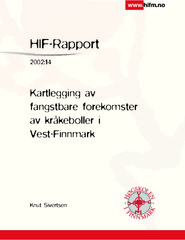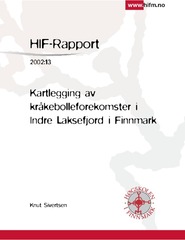Blar i tittel Artikler, rapporter og annet (arktisk og marin biologi)
Viser treff 757-776 av 1513
-
Is Glacial Meltwater a Secondary Source of Legacy Contaminants to Arctic Coastal Food Webs?
(Journal article; Tidsskriftartikkel; Peer reviewed, 2022-04-26)Climate change-driven increases in air and sea temperatures are rapidly thawing the Arctic cryosphere with potential for remobilization and accumulation of legacy persistent organic pollutants (POPs) in adjacent coastal food webs. Here, we present concentrations of selected POPs in zooplankton (spatially and seasonally), as well as zoobenthos and sculpin (spatially) from Isfjorden, Svalbard. ... -
Is the diet cyclic phase-dependent in boreal vole populations?
(Journal article; Tidsskriftartikkel; Peer reviewed, 2024-04-17)Herbivorous rodents in boreal, alpine and arctic ecosystems are renowned for their multi-annual population cycles. Researchers have hypothesised that these cycles may result from herbivore–plant interactions in various ways. For instance, if the biomass of preferred food plants is reduced after a peak phase of a cycle, rodent diets can be expected to become dominated by less preferred food plants, ... -
Isoscape Models of the Southern Ocean: Predicting Spatial and Temporal Variability in Carbon and Nitrogen Isotope Compositions of Particulate Organic Matter
(Journal article; Tidsskriftartikkel; Peer reviewed, 2021-08-30)Polar marine ecosystems are particularly vulnerable to the effects of climate change. Warming temperatures, freshening seawater, and disruption to sea-ice formation potentially all have cascading effects on food webs. New approaches are needed to better understand spatiotemporal interactions among biogeochemical processes at the base of Southern Ocean food webs. In marine systems, isoscapes (models ... -
Isoscape Models of the Southern Ocean: Predicting Spatial and Temporal Variability in Carbon and Nitrogen Isotope Compositions of Particulate Organic Matter
(Journal article; Tidsskriftartikkel; Peer reviewed, 2021-08-30)Polar marine ecosystems are particularly vulnerable to the effects of climate change. Warming temperatures, freshening seawater, and disruption to sea-ice formation potentially all have cascading effects on food webs. New approaches are needed to better understand spatiotemporal interactions among biogeochemical processes at the base of Southern Ocean food webs. In marine systems, isoscapes (models ... -
Isotopic turnover of polar cod (Boreogadus saida) muscle determined through a controlled feeding experiment
(Journal article; Tidsskriftartikkel; Peer reviewed, 2023-03-30)Polar cod (Boreogadus saida) is an important trophic link within Arctic marine food webs and is likely to experience diet shifts in response to climate change. One important tool for assessing organism diet is bulk stable isotope analysis. However, key parameters necessary for interpreting the temporal context of stable isotope values are lacking, especially for Arctic species. This study provides ... -
Issues of under-representation in quantitative DNA metabarcoding weaken the inference about diet of the tundra vole Microtus oeconomus
(Journal article; Tidsskriftartikkel; Peer reviewed, 2021-08-26)During the last decade, methods based on high-throughput sequencing such as DNA metabarcoding have opened up for a range of new questions in animal dietary studies. One of the major advantages of dietary metabarcoding resides in the potential to infer a quantitative relationship between sequence read proportions and biomass of ingested food. However, this relationship’s robustness is highly dependent ... -
Iterative model predictions for wildlife populations impacted by rapid climate change
(Journal article; Tidsskriftartikkel; Peer reviewed, 2021-01-14)To improve understanding and management of the consequences of current rapid environmental change, ecologists advocate using long-term monitoring data series to generate iterative near-term predictions of ecosystem responses. This approach allows scientific evidence to increase rapidly and management strategies to be tailored simultaneously. Iterative near-term forecasting may therefore be particularly ... -
Jellyfish summer distribution, diversity and impact on fish farms in a Nordic fjord
(Journal article; Tidsskriftartikkel; Peer reviewed, 2017-03-19)Jellyfish can cause high mortality of farmed fish and hence significant economic losses for the aquaculture industry. Despite their socio-economic importance, distribution and diversity data on gelatinous plankton are scarce from northern Norwegian fjords and other Nordic systems. Intense blooms of jellyfish have repeatedly been observed in Ryggefjord, Finnmark (Norway), sometimes concurrent with ... -
Joining the dots: systematics and biogeography of Punctoidea land snails
(Conference object; Konferansebidrag, 2022-11) -
Kartlegging av fangstbare forekomster av kråkeboller i Vest-Finnmark
(Research report; Forskningsrapport, 2002) -
Kartlegging av kråkebolleforekomster i Indre Laksefjord i Finnmark
(Research report; Forskningsrapport, 2002) -
Keeping close to the river, shore and surface: the first marine migration of brown trout (Salmo trutta) and Arctic charr (Salvelinus alpinus) post-smolts
(Journal article; Tidsskriftartikkel; Peer reviewed, 2021-03-23)Acoustic telemetry was utilized to track 49 brown trout (<i>Salmo trutta</i>) and 37 Arctic charr (<i>Salvelinus alpinus</i>) first-time migrants of wild origin [post-smolts; mean LF (fork length): 169 and 172 mm] in a large fjord in northern Norway. The <i>S. trutta</i> were registered at sea for more than twice the time of the <i>S. alpinus</i> (medians of 54 and 22 days, respectively). Both species ... -
Keeping the balance in NAD metabolism
(Journal article; Tidsskriftartikkel; Peer reviewed, 2019-01-09)Research over the last few decades has extended our understanding of nicotinamide adenine dinucleotide (NAD) from a vital redox carrier to an important signalling molecule that is involved in the regulation of a multitude of fundamental cellular processes. This includes DNA repair, cell cycle regulation, gene expression and calcium signalling, in which NAD is a substrate for several families of ... -
Kesälaidunnus ei ole ylilaidunnusta
(Journal article; Tidsskriftartikkel, 2019) -
Klimaendringer og virkninger på hovedøkosystem skog.
(Research report; Forskningsrapport, 2022-04-29) -
Knowledge and practices of brucellosis among high-risk groups in Bahr El Ghazal Region, South Sudan
(Journal article; Tidsskriftartikkel; Peer reviewed, 2017-08-03)<b>Background:</b> Brucellosis is the most common zoonotic infections in pastoral settings. Lack of knowledge about the disease may cause devastating out come to the patients, thus sustained it in such communities. This study assessed knowledge and practices among high-risk groups in Bahr el Ghazal region, South Sudan. <br><b>Methods:</b> Across sectional survey involving abattoir workers, febrile ... -
Knowledge base for the assessment of environmental risks by the use of genetically modified virus-vectored vaccines for domesticated animals. Scientific Opinion of the Panel on Microbial Ecology of the Norwegian Scientific Committee for Food Safety
(Research report; Forskningsrapport, 2016)The Norwegian Scientific Committee for Food Safety (VKM) was requested by the Norwegian Environment Agency in November 2015 to develop a knowledge base for assessment of the environmental risks related to the use of genetically modified (GM) virus vaccine vectors for vaccination of domesticated animals. The Agency requested that the task be conducted in the form of a desk study with the following ... -
Konflikter mellom ærfugl og blåskjelldyrking
(Research report; Forskningsrapport, 2006-01)Oppdrett av blåskjell har i de senere år økt sterkt i omfang i Norge, men kunnskapen om de økologiske konsekvensene av virksomheten er meget begrenset. Et betydelig problem som har oppstått i denne forbindelse er predasjon fra fugl, og da særlig ærfugl. Dette har klare negative konsekvenser for lønnsomheten, samt representerer et kunstig habitat og mulige negative påvirkninger for fugl. Bedre ... -
Kunnskapsstatus for bruk av molekylære verktøy i kartlegging og overvåkning av biologisk mangfold i marine miljø
(Research report; Forskningsrapport, 2021-06-02)Denne rapporten er bestilt av Miljødirektoratet fra NorBOL (Norwegian Barcode of Life), et nasjonalt nettverk av forskningsinstitusjoner som koordineres av NTNU Vitenskapsmuseet. Universitetsmuseet i Bergen har hatt prosjektledelsen. Rapporten gir en oppsummering av dagens status på DNA-basert metodikk som verktøy i kartlegging og overvåking av biologisk mangfold i det marine miljø. Fokus har vært ... -
Kvalitetskrav for vann til jordvanning. Uttalelse fra Faggruppen for hygiene og smittestoffer i Vitenskapskomiteen for mattrygghet
(Research report; Forskningsrapport, 2014-05-07)Ved vanning av spiselige jordbruksvekster på friland i Norge brukes det overflatevann, grunnvann eller vann fra gravd brønn. Vannet kan være offentlig eller privat. Mikroorganismer og uønskede kjemiske stoffer i slikt vann kan forårsake sykdom, dersom dette benyttes til vanning av vegetabiler. For sykdomsfremkallende mikroorganismer gjelder dette spesielt ved vanning av vegetabiler som skal spises ...


 English
English norsk
norsk


















